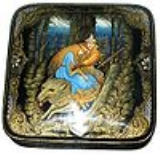
Russian lacquer art
Encyclopedia

Russian icons
The use and making of icons entered Kievan Rus' following its conversion to Orthodox Christianity in 988 AD. As a general rule, these icons strictly followed models and formulas hallowed by Byzantine art, led from the capital in Constantinople...
painting which came to an end with the collapse of Imperial Russia
Russian Empire
The Russian Empire was a state that existed from 1721 until the Russian Revolution of 1917. It was the successor to the Tsardom of Russia and the predecessor of the Soviet Union...
. The icon painters, who previously had been employed by supplying not only churches but people's homes, needed a way to make a living. Thus, the craft of making papier-mâché
Papier-mâché
Papier-mâché , alternatively, paper-mache, is a composite material consisting of paper pieces or pulp, sometimes reinforced with textiles, bound with an adhesive, such as glue, starch, or wallpaper paste....
decorative boxes and panels developed, the items were lacquer
Lacquer
In a general sense, lacquer is a somewhat imprecise term for a clear or coloured varnish that dries by solvent evaporation and often a curing process as well that produces a hard, durable finish, in any sheen level from ultra matte to high gloss and that can be further polished as required...
ed and then hand painted by the artists, often with scenes from folk tales.
The four centers of Russian lacquer art
The village of FedoskinoFedoskino miniature
Fedoskino miniature is a traditional Russian lacquer miniature painting on papier-mache, named after its original center Fedoskino , an old village near Moscow widely known from the late 18th century...
(Федоскино)http://www.instaplanet.com/fedoskino.html, located not far from Moscow
Moscow
Moscow is the capital, the most populous city, and the most populous federal subject of Russia. The city is a major political, economic, cultural, scientific, religious, financial, educational, and transportation centre of Russia and the continent...
on the banks of the Ucha River
Ucha River
Ucha River is a river in Moscow Oblast, Russia. It is a left tributary of the Klyazma River.The Ucha is 42 km in length, with a drainage basin of 605 km². It flows through the towns of Pushkino and Ivanteyevka, and flows into the Klyazma River at the town of Shchyolkovo.Tributaries:...
, is the oldest of the four art centers of Russian lacquer miniature painting on papier-mâché
Papier-mâché
Papier-mâché , alternatively, paper-mache, is a composite material consisting of paper pieces or pulp, sometimes reinforced with textiles, bound with an adhesive, such as glue, starch, or wallpaper paste....
, which has been practiced there since 1795. It stands apart both geographically, and in that that oil paints are used rather than egg tempera. While allowing the artist a free hand in impressionistic
Impressionism
Impressionism was a 19th-century art movement that originated with a group of Paris-based artists whose independent exhibitions brought them to prominence during the 1870s and 1880s...
interpretation, the style of Fedoskino painting is largely realistic in composition and detail.
The other three Russian lacquer art centers are:
- PalekhPalekh miniaturePalekh miniature is a Russian folk handicraft of miniature painting, which is done with tempera paints on varnished articles made of papier-mâché ....
(Палех) - KholuyKholuy miniatureA Kholuy miniature is a Russian folk handicraft of miniature painting, made with tempera on a varnished box of papier-mâché. This form of Russian lacquer art is produced exclusively by students of the Kholuy school, a rural settlement in Ivanovo Oblast....
(Kholuy, Kholuj, Holui - Холуй) - MstyoraMstyora miniatureMstyora miniature is a Russian folk handicraft of miniature painting, which is done with tempera paints on varnished articles mostly made of papier-mâché....
(Мстёра)
The lacquer artists of Palekh, Kholui and Mstera continue to use the technique of painting in egg-based tempera overlaid with intricate gold leaf highlighting.
All three are situated in the Vladimir-Suzdal
Vladimir-Suzdal
The Vladimir-Suzdal Principality or Vladimir-Suzdal Rus’ was one of the major principalities which succeeded Kievan Rus' in the late 12th century and lasted until the late 14th century. For a long time the Principality was a vassal of the Mongolian Golden Horde...
Principality, Ivanovo region of central Russia
Russia
Russia or , officially known as both Russia and the Russian Federation , is a country in northern Eurasia. It is a federal semi-presidential republic, comprising 83 federal subjects...
, and are deeply rooted in the 17th-19th century icon
Icon
An icon is a religious work of art, most commonly a painting, from Eastern Christianity and in certain Eastern Catholic churches...
painting tradition, which lasted until the Russian Revolution of 1917
Russian Revolution of 1917
The Russian Revolution is the collective term for a series of revolutions in Russia in 1917, which destroyed the Tsarist autocracy and led to the creation of the Soviet Union. The Tsar was deposed and replaced by a provisional government in the first revolution of February 1917...
and is now being revived by young artists of the 21st century.
The quality of lacquer boxes varies widely. Tourists are frequently instructed that a signature on the bottom of the box indicates that a master painted it. However, the reality of the lacquer box industry is that most are painted in small factories where signing another artist's name is no more difficult than painting in his style. Instead of checking for the signature of an artist that can never be confirmed, instead consider the actual quality and detail of the artwork. Many of the lacquer boxes produced in the Soviet Union have exceptional detail and command astronomical prices, yet have no signature. The myth of the signature is perpetuated by the people that sell the boxes rather than those that paint the boxes.

